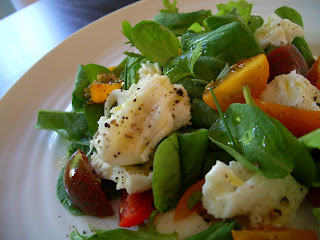 |
| Fagioli beans in Emiliana's hand. |
My dad falls firmly into the love category -- in fact fagioli is practically a religion in our family. We grow them every summer, spend time together harvesting and shelling them, freeze them, eat them all winter, and have heated debates about whether we should add potatoes to a particular batch. My brother Paolo has been known to eat nothing else for days and swears it is the best possible breakfast.
In our family, we use the word fagioli exclusively, but I have learned the beans we are referring to are more commonly called cranberry beans, a perfect name given the deep red veins of colour running through both the pods and the beans themselves. To add to the confusion, we also use the same word for both the beans and for the dish, a thick stew/soup of celery, onion, carrot and lots of beans. It is wonderful as a vegetarian dish, and also great with a good chunk of pork in it.
As with most of our family recipes, I learned it without measurements, just ingredients, so the measurements below are approximate, and nothing to be too particular about. Cook from your heart and you can't go wrong with a rustic, wholesome dish like this.
2 large onions
2 large carrots
3 or 4 celery stalks (with lots of leaves)
3 or 4 celery stalks (with lots of leaves)
1 leak
3 or 4 garlic cloves
2 small tomatoes (skins removed)
3 or 4 garlic cloves
2 small tomatoes (skins removed)
2 cups cranberry beans (canned or frozen - if dried, prepare/soak in advance. Romano beans also work well)
4 tablespoons canola oil (canola is what my Nonna would have used, olive oil is fine too)
2 or 3 pork ribs
3 cups water
Salt & pepper
Freshly grated Parmigiano, Montasio or Pecorino Romano cheese
Handful of parsley
Salt & pepper
Freshly grated Parmigiano, Montasio or Pecorino Romano cheese
Handful of parsley
Finely chop all of the vegetables (except parsley) and sauté in the oil until softened. Add the meat and continue to cook for 10 or 15 minutes. Add beans and water. Simmer gently for about an hour, more is better. Season with salt and pepper.
Remove 1 to 2 cups of the soup and puree it in a blender, then add it back into the pot so about half of the beans are still whole, and the rest have added a creamy rich texture to your dish. (My mom accomplishes this without using her blender, she takes a big wooden spoon and gently mashes a little less than half of the beans against the side of the pot - it is old-world perfection).
Reheat before serving, stir in a handful of freshly chopped parsley and top each serving with a generous grating of cheese. It is one of those magical soups that is better the next day.















